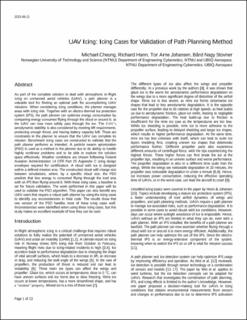| dc.contributor.author | Cheung, Michael | |
| dc.contributor.author | Hann, Richard | |
| dc.contributor.author | Johansen, Tor Arne | |
| dc.contributor.author | Stovner, Bård Nagy | |
| dc.date.accessioned | 2023-09-01T05:56:36Z | |
| dc.date.available | 2023-09-01T05:56:36Z | |
| dc.date.created | 2023-08-07T18:45:48Z | |
| dc.date.issued | 2023 | |
| dc.identifier.issn | 0148-7191 | |
| dc.identifier.uri | https://hdl.handle.net/11250/3086760 | |
| dc.description.abstract | As part of the complete solution to deal with atmospheric in-flight icing on unmanned aerial vehicles (UAV), a path planner is a valuable tool for finding an optimal path for accomplishing UAV missions. When considering icing conditions, the planner manages areas with icing risk. Together with an electro-thermal ice protection system (IPS), the path planner can optimize energy consumption by comparing energy consumed flying through the cloud or around it, as the UAV can now more safely pass through the ice. The UAV’s aerodynamic stability is also considered by meeting lift requirements, producing enough thrust, and having battery capacity left. These are constraints in the planner to ensure that the UAV can complete its mission. Benchmark icing cases are constructed to validate that the path planner performs as intended. A particle swarm optimization (PSO) is used as a method in the planner due to its ability to handle highly nonlinear problems and to be able to explore the solution space effectively. Weather conditions are chosen following Federal Aviation Administration 14 CFR Part 25 Appendix C icing design envelopes required for certification. A cloud with ice is designed within a defined mission area. The constructed cloud will change size between simulations, where, by a specific cloud size, the PSO predicts that less energy is consumed flying through the iced area with an IPS than flying around it. With these icing cases, a baseline is set for future validation. The work performed in this paper will be used to validate the PSO algorithm. This paper can also benefit any UAV users that require a robust path planner by using the icing cases to identify any inconsistencies in their code. The results show that one version of the PSO handles most of these icing cases well. Inconsistencies were identified when using these icing cases, but this study makes an excellent example of how they can be used. | en_US |
| dc.language.iso | eng | en_US |
| dc.publisher | SAE | en_US |
| dc.rights | Navngivelse 4.0 Internasjonal | * |
| dc.rights.uri | http://creativecommons.org/licenses/by/4.0/deed.no | * |
| dc.title | UAV Icing: Icing Cases for Validation of Path Planning Method | en_US |
| dc.title.alternative | UAV Icing: Icing Cases for Validation of Path Planning Method | en_US |
| dc.type | Peer reviewed | en_US |
| dc.type | Journal article | en_US |
| dc.description.version | acceptedVersion | en_US |
| dc.source.journal | SAE technical paper series | en_US |
| dc.identifier.doi | 10.4271/2023-01-1379 | |
| dc.identifier.cristin | 2165460 | |
| dc.relation.project | Norges forskningsråd: 296228 | en_US |
| cristin.ispublished | true | |
| cristin.fulltext | postprint | |
| cristin.qualitycode | 1 | |

